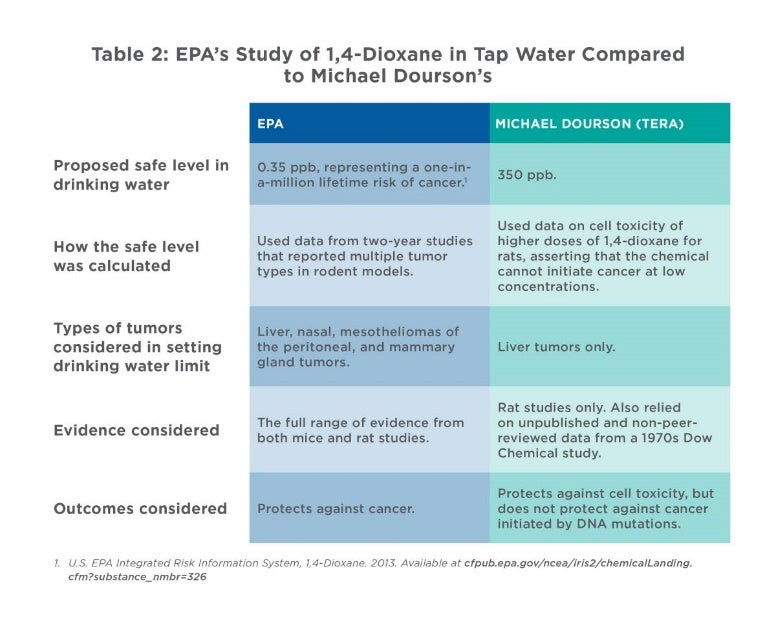Richard Denison, Ph.D., is a Lead Senior Scientist. Jack Pratt is Chemicals Campaign Director.
[Use this link to see all of our posts on Dourson.]
A report issued today by the Environmental Working Group (EWG) documents that the industrial chemical 1,4-dioxane, a likely human carcinogen, is present in tap water used by nearly 90 million Americans living in 45 states. For more than 7 million of those people (living in 27 states), the average level of the chemical exceeds the level set by the Environmental Protection Agency (EPA) as presenting an increased risk of cancer, which is one among a number of health effects tied to the chemical.
The solvent 1,4-dioxane is manufactured in large amounts in the U.S., with EPA reporting a total volume in 2015 between 1 and 10 million pounds. It is intentionally used or present in products like paints and coatings, greases, waxes, varnishes and dyes. It is also found as an impurity in many household cleaning and personal care products.
Among the other reasons this chemical is currently notable:
- It is one of the first 10 chemicals being evaluated by EPA under the recently reformed Toxic Substances Control Act to determine whether it presents an unreasonable risk and warrants regulation. Currently there is no legal enforceable limit on the amount of the chemical allowed in drinking water.
- It is one of a number of chemicals that Michael Dourson, the Trump Administration’s nominee to lead the EPA toxics office, was paid to work on by the chemical industry. EDF has blogged extensively about Dourson’s close ties to the chemical industry as well as earlier work he did for the tobacco industry. In the case of 1,4-dioxane, Dourson was hired by PPG Industries, a paints and coatings manufacturer that has released the chemical into the environment, leading to contamination of a public water supply in Ohio.
In a 2014 paper, published in the industry’s go-to journal, Dourson argued for an acceptable level of 1,4-dioxane in water that was 1,000 times higher than EPA’s drinking water guideline reflecting elevated risk of cancer. The accompanying chart from the EWG report helpfully illustrates the selective information and analysis Dourson used to derive his weaker standard. EWG’s report notes that a review of Dourson’s work by the State of Michigan rejected his work as flawed and embraced EPA’s more comprehensive methodology.
A Pattern of Downplaying Concerns
The case of 1,4-dioxane is hardly unique: Dourson’s paid work for industry dates back decades, including work he did for the tobacco industry in the late 1990s and early 2000s. As reported in The Intercept, internal industry emails reveal that Dourson’s firm had “a very good reputation among the folks that are still in the business of blessing criteria.” In that case, the company in question hoped Dourson’s firm could argue for a looser threshold for the chemical PFOA—a toxic chemical that has polluted water supplies in West Virginia, Ohio and New York. (EWG has mapped contamination from PFOA and related chemicals as well.)
In fact, Dourson or TERA were paid for their work by more than three dozen companies or trade associations, involving at least three dozen different chemicals.
Several of these chemicals, including 1,4-dioxane, are under active review by the very EPA office Dourson has been nominated to head, including trichloroethylene (TCE) and the pesticide chlorpyrifos—itself, the subject of a highly controversial decision by EPA Administrator Scott Pruitt to reject a ban of the pesticide backed by agency scientists.
Dourson’s track record of downplaying risks posed by toxic chemicals makes it obvious why his firm was sought after by chemical makers. What is of far greater concern is the notion that he should be entrusted with ensuring chemical safety at EPA.
Senators representing states whose water supplies have been impacted by 1,4-dioxane, PFOA and other Dourson-endorsed chemicals should ask tough questions of this nominee. And residents of those states should urge their Senators to oppose the nomination of Michael Dourson to lead the toxics office at EPA.









